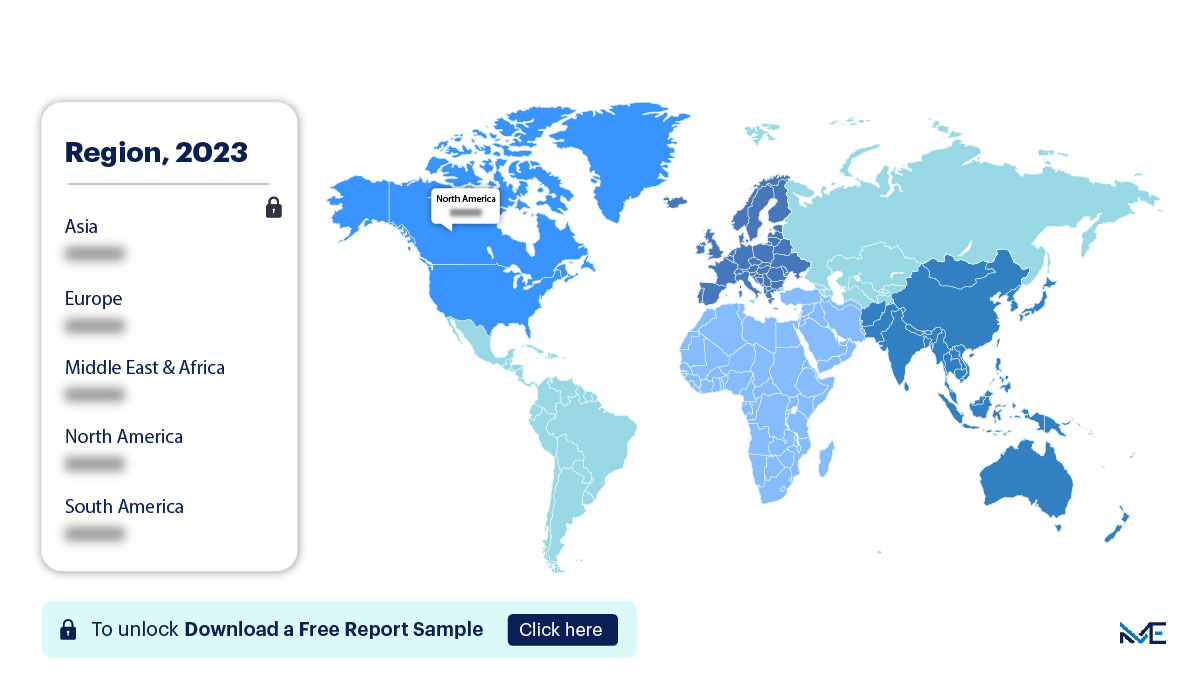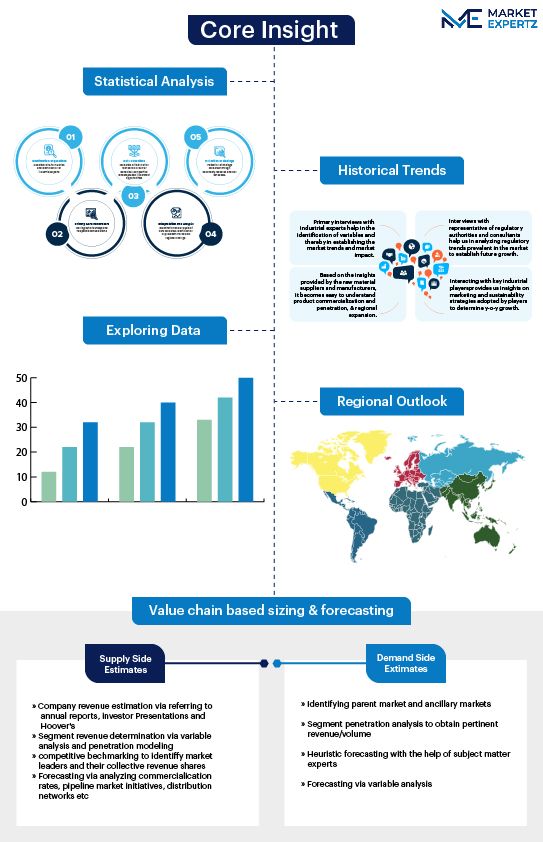Market Snapshot
| Study Period | 2019-2032 |
| Base Year | 2023 |
| Forcast Year | 2023-2032 |
| CAGR | 9.34 |


Gain accurate insights regarding the negative impacts of COVID-19 on all markets and industries
Download Sample PdfReport Overview
Power System State Estimator Market Analysis By Application (Energy Management, Fault Detection, Power System Control), By Type (WLS, LAV, Kalman Filter, Others), and By Region Forecast to 2032:
The Power System State Estimator Market is projected to experience substantial growth with a Compound Annual Growth Rate (CAGR) of 5.72% between 2022 and 2032. This growth is expected to result in an estimated increase of USD 12,345.67 million in market size. The expansion of this market is influenced by several key factors, including the increasing complexity of power grids, the need for efficient energy management, and advancements in state estimation technologies. A power system state estimator is a crucial tool for monitoring and optimizing the operation of power generation and distribution networks.
Power System State Estimator Market Overview:
Drivers:
One of the primary drivers fueling the growth of the Power System State Estimator Market is the growing complexity of modern power grids. With the integration of renewable energy sources, demand response systems, and smart grid technologies, power grids have become more intricate. State estimators provide real-time insights into grid conditions, helping utilities and grid operators make informed decisions to ensure grid stability and reliability.
Furthermore, the increasing emphasis on energy management and conservation drives the adoption of state estimator solutions. Utilities and energy companies are looking to optimize energy generation and distribution, reduce losses, and enhance energy efficiency. Power system state estimators play a vital role in achieving these objectives.
Trends:
An emerging trend shaping the Power System State Estimator Market is the utilization of advanced state estimation algorithms. Algorithms such as Weighted Least Squares (WLS), Least Absolute Value (LAV), and Kalman Filters are being employed to improve the accuracy and robustness of state estimation. These advancements are particularly important in scenarios where grid conditions change rapidly, such as during faults or disturbances.
Additionally, the integration of state estimation with fault detection systems and power system control is positively impacting market growth. This integrated approach allows utilities to not only estimate the state of the grid but also take proactive measures to mitigate issues and enhance grid resilience.
Restraints:
One of the key challenges hindering the growth of the Power System State Estimator Market is the high initial cost of implementing state estimation solutions. Deploying state estimator software and hardware, along with the necessary training and infrastructure upgrades, can be capital-intensive for utilities and grid operators. Cost considerations may delay adoption in some regions.
Moreover, ensuring the cybersecurity of state estimation systems is a significant concern. Power grids are critical infrastructure, and any vulnerabilities in state estimator software or data communication networks could pose security risks. Addressing these concerns and implementing robust cybersecurity measures are essential for market growth.
Power System State Estimator Market Segmentation By Application:
- Energy Management: Power system state estimators are extensively used for energy management, allowing utilities to optimize generation, distribution, and consumption of electrical energy.
- Fault Detection: State estimators play a crucial role in detecting faults and disturbances in the power grid, enabling rapid response to minimize disruptions.
- Power System Control: These solutions are integrated into power system control centers to monitor grid conditions and make real-time decisions for grid stability and reliability.
Power System State Estimator Market Segmentation By Type:
- WLS (Weighted Least Squares): WLS state estimation is a widely used method for estimating the state of power systems by minimizing the weighted sum of squares of discrepancies between measurements and estimates.
- LAV (Least Absolute Value): LAV state estimation minimizes the sum of the absolute values of discrepancies between measurements and estimates, making it robust against outliers.
- Kalman Filter: Kalman Filter-based state estimation is known for its ability to handle time-varying dynamics and is often used in dynamic state estimation applications.
Regional Overview:

Download the report summary now!
Request pdf Sample
North America is poised to be a key contributor to the global Power System State Estimator Market, accounting for approximately 38% of the market's growth during the forecast period. The region's aging power infrastructure and the need for grid modernization initiatives drive the demand for state estimation solutions. Additionally, regulatory support for grid reliability and renewable energy integration further fuels market growth.
Asia-Pacific is another significant region in the market, with rapid urbanization and industrialization driving the expansion of power generation and distribution networks. Utilities in this region are increasingly investing in state estimation technologies to ensure grid stability and meet growing energy demands.
Power System State Estimator Market Customer Landscape:
The Power System State Estimator Market report encompasses the customer adoption lifecycle, ranging from early adopters to mainstream users. It delves into adoption rates across different regions based on penetration and includes key purchase criteria and price sensitivity drivers to assist companies in formulating effective growth strategies.
Major Power System State Estimator Market Companies:
Companies in the power system state estimator market are employing diverse strategies such as research and development, partnerships, mergers, acquisitions, and product/service launches to strengthen their market presence.
Example companies include:
- General Electric Company: GE offers state estimator solutions for utilities and grid operators, focusing on grid optimization and stability.
- Siemens AG: Siemens provides advanced state estimation technologies as part of its portfolio for smart grid solutions.
- Schneider Electric SE: Schneider Electric offers state estimator systems designed for real-time grid monitoring and control.
The competitive landscape analysis in the report provides insights into 20 key market players, including:
- ABB Group
- Honeywell International Inc.
- Eaton Corporation
- Emerson Electric Co.
- Rockwell Automation, Inc.
- Mitsubishi Electric Corporation
- Fuji Electric Co., Ltd.
- Yokogawa Electric Corporation
- Schweitzer Engineering Laboratories, Inc.
Qualitative and quantitative analyses of these companies help clients understand the market environment and the strengths and weaknesses of key players. Companies are categorized based on focus, dominance, and strength.
Segment Overview:
The Power System State Estimator Market report forecasts revenue growth at global, regional, and country levels and offers an analysis of trends and growth opportunities from 2019 to 2032.
- Application Outlook (USD Million, 2019 - 2032):
- Energy Management
- Fault Detection
- Power System Control
- Type Outlook (USD Million, 2019 - 2032):
- WLS (Weighted Least Squares)
- LAV (Least Absolute Value)
- Kalman Filter
- Others
- Geography Outlook (USD Million, 2019 - 2032):
- North America
- United States
- Canada
- Europe
- United Kingdom
- Germany
- France
- Rest of Europe
- Asia-Pacific
- China
- Japan
- India
- Rest of Asia-Pacific
- Latin America
- Brazil
- Mexico
- Rest of Latin America
- Middle East & Africa
- United Arab Emirates
- South Africa
- Rest of Middle East & Africa
TABLE OF CONTENTS: GLOBAL POWER SYSTEM STATE ESTIMATOR MARKET
Chapter 1. MARKET SYNOPSIS
1.1. Market Definition
1.2. Research Scope & Premise
1.3. Methodology
1.4. Market Estimation Technique
Chapter 2. EXECUTIVE SUMMARY
2.1. Summary Snapshot, 2016 – 2027
Chapter 3. INDICATIVE METRICS
3.1. Macro Indicators
Chapter 4. POWER SYSTEM STATE ESTIMATOR MARKET SEGMENTATION & IMPACT ANALYSIS
4.1. Power System State Estimator Segmentation Analysis
4.2. Industrial Outlook
4.3. Price Trend Analysis
4.4. Regulatory Framework
4.5. Porter’s Five Forces Analysis
4.5.1. Power Of Suppliers
4.5.2. Power Of Buyers
4.5.3. Threat Of Substitutes
4.5.4. Threat Of New Entrants
4.5.5. Competitive Rivalry
Chapter 5. POWER SYSTEM STATE ESTIMATOR MARKET BY Software Type INSIGHTS & TRENDS
5.1. Segment 1 Dynamics & Market Share, 2019 & 2027
5.2. Utility
5.2.1. Market Estimates And Forecast, 2016 – 2027 (USD Million)
5.2.2. Market Estimates And Forecast, By Region, 2016 – 2027 (USD Million)
5.3. Power Control Centers
5.3.1. Market Estimates And Forecast, 2016 – 2027 (USD Million)
5.3.2. Market Estimates And Forecast, By Region, 2016 – 2027 (USD Million)
Chapter 6. POWER SYSTEM STATE ESTIMATOR MARKET BY Application INSIGHTS & TRENDS
6.1. Segment 2 Dynamics & Market Share, 2019 & 2027
6.2. Transmission
6.2.1. Market Estimates And Forecast, 2016 – 2027 (USD Million)
6.2.2. Market Estimates And Forecast, By Region, 2016 – 2027 (USD Million)
6.3. Distribution Networks
6.3.1. Market Estimates And Forecast, 2016 – 2027 (USD Million)
6.3.2. Market Estimates And Forecast, By Region, 2016 – 2027 (USD Million)
Chapter 7. POWER SYSTEM STATE ESTIMATOR MARKET REGIONAL OUTLOOK
7.1. Power System State Estimator Market Share By Region, 2019 & 2027
7.2. NORTH AMERICA
7.2.1. North America Power System State Estimator Market Estimates And Forecast, 2016 – 2027, (USD Million)
7.2.2. North America Power System State Estimator Market Estimates And Forecast By Segment 1, 2016 –2027, (USD Million)
7.2.3. North America Power System State Estimator Market Estimates And Forecast By Segment 2, 2016 –2027, (USD Million)
7.2.4. North America Power System State Estimator Market Estimates And Forecast By Segment 3, 2016 –2027, (USD Million)
7.2.5. U.S.
7.2.5.1. U.S. Power System State Estimator Market Estimates And Forecast, 2016 – 2027, (USD Million)
7.2.5.2. U.S. Power System State Estimator Market Estimates And Forecast By Segment 1, 2016 –2027, (USD Million)
7.2.5.3. U.S. Power System State Estimator Market Estimates And Forecast By Segment 2, 2016 –2027, (USD Million)
7.2.5.4. U.S. Power System State Estimator Market Estimates And Forecast By Segment 3, 2016 –2027, (USD Million)
7.2.6. CANADA
7.2.6.1. Canada Power System State Estimator Market Estimates And Forecast, 2016 – 2027, (USD Million)
7.2.6.2. Canada Power System State Estimator Market Estimates And Forecast By Segment 1, 2016 –2027, (USD Million)
7.2.6.3. Canada Power System State Estimator Market Estimates And Forecast By Segment 2, 2016 –2027, (USD Million)
7.2.6.4. Canada Power System State Estimator Market Estimates And Forecast By Segment 3, 2016 –2027, (USD Million)
7.3. EUROPE
7.3.1. Europe Power System State Estimator Market Estimates And Forecast, 2016 – 2027, (USD Million)
7.3.2. Europe Power System State Estimator Market Estimates And Forecast By Segment 1, 2016 –2027, (USD Million)
7.3.3. Europe Power System State Estimator Market Estimates And Forecast By Segment 2, 2016 –2027, (USD Million)
7.3.4. Europe Power System State Estimator Market Estimates And Forecast By Segment 3, 2016 –2027, (USD Million)
7.3.5. GERMANY
7.3.5.1. Germany Power System State Estimator Market Estimates And Forecast, 2016 – 2027, (USD Million)
7.3.5.2. Germany Power System State Estimator Market Estimates And Forecast By Segment 1, 2016 –2027, (USD Million)
7.3.5.3. Germany Power System State Estimator Market Estimates And Forecast By Segment 2, 2016 –2027, (USD Million)
7.3.5.4. Germany Power System State Estimator Market Estimates And Forecast By Segment 3, 2016 –2027, (USD Million)
7.3.6. FRANCE
7.3.6.1. France Power System State Estimator Market Estimates And Forecast, 2016 – 2027, (USD Million)
7.3.6.2. France Power System State Estimator Market Estimates And Forecast By Segment 1, 2016 –2027, (USD Million)
7.3.6.3. France Power System State Estimator Market Estimates And Forecast By Segment 2, 2016 –2027, (USD Million)
7.3.6.4. France Power System State Estimator Market Estimates And Forecast By Segment 3, 2016 –2027, (USD Million)
7.3.7. U.K.
7.3.7.1. U.K. Power System State Estimator Market Estimates And Forecast, 2016 – 2027, (USD Million)
7.3.7.2. U.K. Power System State Estimator Market Estimates And Forecast By Segment 1, 2016 –2027, (USD Million)
7.3.7.3. U.K. Power System State Estimator Market Estimates And Forecast By Segment 2, 2016 –2027, (USD Million)
7.3.7.4. U.K. Power System State Estimator Market Estimates And Forecast By Segment 3, 2016 –2027, (USD Million)
7.4. ASIA-PACIFIC
7.4.1. Asia Pacific Power System State Estimator Market Estimates And Forecast, 2016 – 2027, (USD Million)
7.4.2. Asia Pacific Power System State Estimator Market Estimates And Forecast By Segment 1, 2016 –2027, (USD Million)
7.4.3. Asia Pacific Power System State Estimator Market Estimates And Forecast By Segment 2, 2016 –2027, (USD Million)
7.4.4. Asia Pacific Power System State Estimator Market Estimates And Forecast By Segment 3, 2016 –2027, (USD Million)
7.4.5. CHINA
7.4.5.1. China Power System State Estimator Market Estimates And Forecast, 2016 – 2027, (USD Million)
7.4.5.2. China Power System State Estimator Market Estimates And Forecast By Segment 1, 2016 –2027, (USD Million)
7.4.5.3. China Power System State Estimator Market Estimates And Forecast By Segment 2, 2016 –2027, (USD Million)
7.4.5.4. China Power System State Estimator Market Estimates And Forecast By Segment 3, 2016 –2027, (USD Million)
7.4.6. INDIA
7.4.6.1. India Power System State Estimator Market Estimates And Forecast, 2016 – 2027, (USD Million)
7.4.6.2. India Power System State Estimator Market Estimates And Forecast By Segment 1, 2016 –2027, (USD Million)
7.4.6.3. India Power System State Estimator Market Estimates And Forecast By Segment 2, 2016 –2027, (USD Million)
7.4.6.4. India Power System State Estimator Market Estimates And Forecast By Segment 3, 2016 –2027, (USD Million)
7.4.7. JAPAN
7.4.7.1. Japan Power System State Estimator Market Estimates And Forecast, 2016 – 2027, (USD Million)
7.4.7.2. Japan Power System State Estimator Market Estimates And Forecast By Segment 1, 2016 –2027, (USD Million)
7.4.7.3. Japan Power System State Estimator Market Estimates And Forecast By Segment 2, 2016 –2027, (USD Million)
7.4.7.4. Japan Power System State Estimator Market Estimates And Forecast By Segment 3, 2016 –2027, (USD Million)
7.4.8. AUSTRALIA
7.4.8.1. Australia Power System State Estimator Market Estimates And Forecast, 2016 – 2027, (USD Million)
7.4.8.2. Australia Power System State Estimator Market Estimates And Forecast By Segment 1, 2016 –2027, (USD Million)
7.4.8.3. Australia Power System State Estimator Market Estimates And Forecast By Segment 2, 2016 –2027, (USD Million)
7.4.8.4. Australia Power System State Estimator Market Estimates And Forecast By Segment 3, 2016 –2027, (USD Million)
7.5. MIDDLE EAST AND AFRICA (MEA)
7.5.1. Mea Power System State Estimator Market Estimates And Forecast, 2016 – 2027, (USD Million)
7.5.2. Mea Power System State Estimator Market Estimates And Forecast By Segment 1, 2016 –2027, (USD Million)
7.5.3. Mea Power System State Estimator Market Estimates And Forecast By Segment 2, 2016 –2027, (USD Million)
7.5.4. Mea Power System State Estimator Market Estimates And Forecast By Segment 3, 2016 –2027, (USD Million)
7.6. LATIN AMERICA
7.6.1. Latin America Power System State Estimator Market Estimates And Forecast, 2016 – 2027, (USD Million)
7.6.2. Latin America Power System State Estimator Market Estimates And Forecast By Segment 1, 2016 –2027, (USD Million)
7.6.3. Latin America Power System State Estimator Market Estimates And Forecast By Segment 2, 2016 –2027, (USD Million)
7.6.4. Latin America Power System State Estimator Market Estimates And Forecast By Production Process, 2016 –2027, (USD Million)
7.6.5. Latin America Power System State Estimator Market Estimates And Forecast By Segment 3, 2016 –2027, (USD Million)
Chapter 8. COMPETITIVE LANDSCAPE
8.1. Market Share By Manufacturers
8.2. Strategic Benchmarking
8.2.1. New Product Launches
8.2.2. Investment & Expansion
8.2.3. Acquisitions
8.2.4. Partnerships, Agreement, Mergers, Joint-Ventures
8.3. Vendor Landscape
8.3.1. North American Suppliers
8.3.2. European Suppliers
8.3.3. Asia-Pacific Suppliers
8.3.4. Rest Of The World Suppliers
Chapter 9. COMPANY PROFILES
9.1. Open Systems International Inc. (U.S.)
9.1.1. Company Overview
9.1.2. Financial Performance
9.1.3. Product Insights
9.1.4. Strategic Initiatives
9.2. General Electric (U.S.)
9.2.1. Company Overview
9.2.2. Financial Performance
9.2.3. Product Insights
9.2.4. Strategic Initiatives
9.3. Nexant (U.S.)
9.3.1. Company Overview
9.3.2. Financial Performance
9.3.3. Product Insights
9.3.4. Strategic Initiatives
9.4. ETAP/Operation Technology Inc. (U.S.)
9.4.1. Company Overview
9.4.2. Financial Performance
9.4.3. Product Insights
9.4.4. Strategic Initiatives
9.5. CYME International (Canada)
9.5.1. Company Overview
9.5.2. Financial Performance
9.5.3. Product Insights
9.5.4. Strategic Initiatives
9.6. ABB Ltd. (Switzerland)
9.6.1. Company Overview
9.6.2. Financial Performance
9.6.3. Product Insights
9.6.4. Strategic Initiatives
9.7. Siemens AG (Germany)
9.7.1. Company Overview
9.7.2. Financial Performance
9.7.3. Product Insights
9.7.4. Strategic Initiatives
9.8. DIgSILENT GmbH (Germany)
9.8.1. Company Overview
9.8.2. Financial Performance
9.8.3. Product Insights
9.8.4. Strategic Initiatives
9.9. Neplan AG (Switzerland)
9.9.1. Company Overview
9.9.2. Financial Performance
9.9.3. Product Insights
9.9.4. Strategic Initiatives
9.10. Alstom (France)
9.10.1. Company Overview
9.10.2. Financial Performance
9.10.3. Product Insights
9.10.4. Strategic Initiatives
RESEARCH METHODOLOGY
A research methodology is a systematic approach for assessing or conducting a market study. Researchers tend to draw on a variety of both qualitative and quantitative study methods, inclusive of investigations, survey, secondary data and market observation.
Such plans can focus on classifying the products offered by leading market players or simply use statistical models to interpret observations or test hypotheses. While some methods aim for a detailed description of the factors behind an observation, others present the context of the current market scenario.
Now let’s take a closer look at the research methods here.
Secondary Research Model
Extensive data is obtained and cumulated on a substantial basis during the inception phase of the research process. The data accumulated is consistently filtered through validation from the in-house database, paid sources as well reputable industry magazines. A robust research study requires an understanding of the overall value chain. Annual reports and financials of industry players are studied thoroughly to have a comprehensive idea of the market taxonomy.
Primary Insights
Post conglomeration of the data obtained through secondary research; a validation process is initiated to verify the numbers or figures. This process is usually performed by having a detailed discussion with the industry experts.
However, we do not restrict our primary interviews only to the industry leaders. Our team covers the entire value chain while verifying the data. A significant number of raw material suppliers, local manufacturers, distributors, and stakeholders are interviewed to make our findings authentic. The current trends which include the drivers, restraints, and opportunities are also derived through the primary research process.
Market Estimation
The market estimation is conducted by analyzing the data collected through both secondary and primary research. This process involves market breakdown, bottom-up and top- down approach.
Moreover, while forecasting the market a comprehensive statistical time series model is designed for each market. Macroeconomic indicators are considered to understand the current trends of the market. Each data point is verified by the process of data triangulation method to arrive at the final market estimates.
Final Presentation
The penultimate process results in a holistic research report. The study equips key industry players to undertake significant strategic decisions through the findings. The report encompasses detailed market information. Graphical representations of the current market trends are also made available in order to make the study highly comprehensible for the reader.
Personalized Business Report Tailored to Your Requirements
- Our expert analysts collaborate directly with you to comprehend your specific needs.
- Get data on regions, segments, competitors, and vendors of your choice.
- Information is presented in alignment with your exact preferences and formatting.
Free Sample Report
"Find new revenue generation opportunities"

